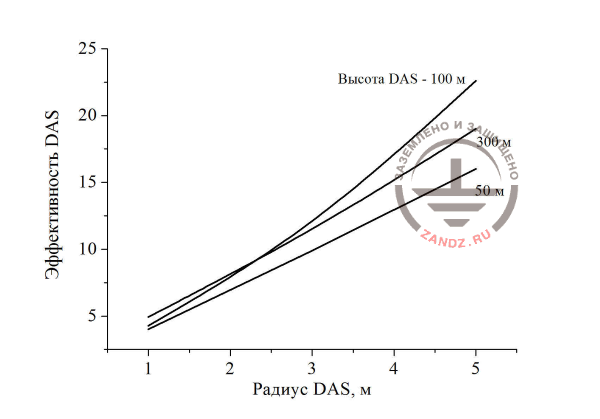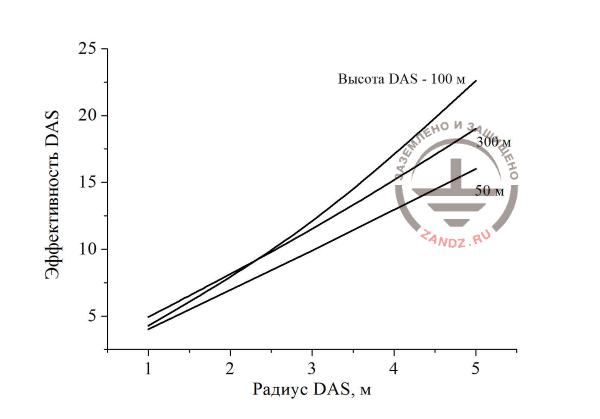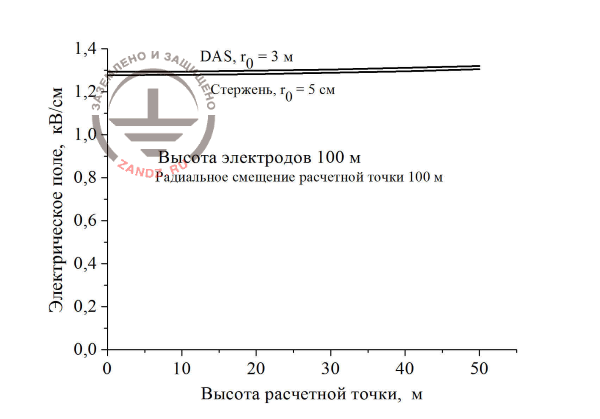Article by profoessor Eduard Meerovich Bazelyan "Dissipation array system" for high-rise objects
<< back to the first part
The efficiency of the device "Dissipation array system" is quantitavely fixed at the order of relation of contraction radius squares, counted for the device of the fixed construction and for the rod lightning rod of ordinary execution of the same height.

Figure 6. The efficiency of the protective action of the device "dissipation array system"
depending on its radius for objects of different height
The value obtained this way indicates the order of reduction of number of strikes into the object, covered by the "dissipation array system".
Calculated data in fig. 6 characterize this device with the spires 10 cm high and tadius of 0,07 cm, which are located over the surface with the distance of 10 cm between them.
It is necessary to underline two crucial moments. Firstly, unline the rod lightning rod, the "dissipation array system" device, mounted above the object, does't capture lightning channel, but significantly reduces the probability of its orientation in the direction of the system of "dissipation array system+ protected object. Secondly, reducing the number of lightning strikes into this system, "dissipation array system" correspondingly reduces the number of close, and, consequently, dangerous effects of electromagnetic field of lightning current. The latter is especially important, when high-rise buildings are located on the territory of the protected object, similar to chimney or ventilation pipes, high-frequency antenna or chemical reactor columns. As a rule, such structures themselves stand the contact with the lightning channel without any consequences and that is why need to be protected with lightning rods. However, they are lightning concentrators, the electromagnetic field of which becomes a source of dangerous thuunder overvoltages for electric circuits of the neighbouring structures. The installation of the "dissipation array system" performs the role of a cap of darkness, literally hiding the high-rise buildings from lightning as it comes from calculated data fig. 6, at the radius of "dissipation array system" 3-5 m the number of lightning strikes in a high-rise building can be reduced to an order of mgnitude and this way to significantly reduce electromagnetic environment in its vicinity.
The question about the possibility of comparison of "dissipation array system" device with lightning rods of traditional execution is quite legitimate. The answer to it is of course negative, that is why "dissipation array system" is not a lightning rod even in principle of its action. As known, lightning rod contracts lightning channels upon itself from a certain area, this way eliminating their damages on the constructions of minor height. "Dissipation array system" cannot fulfil this function. It "hides" its own surface and the object under it from the forming lightning. Its influence on the electric field in the nearest vicinity is little significant. Calculated data in fig. 7 and 8 allow to compare the image of electric field distribution in height on the distance of 100 m from the "dissipation array system" device and from the rod lightning rod of the same height. Calculation fig. 7 corresponds to the time moment 10 s, when the electric field of a thunderstorm cloud managed to grow linearly to 20 kV/m and the calculation in fig. 8 also considers the downward lightning leader field, descending along the vertical axis to the top of electrodes.

Figure 7. The distribution of the electric field in height on the distance of 100 m
from the corona electrode in a thunderstorm cloud field
Эффективность - efficiency; Радиус – radius; Высота - height

Figure 8. The distribution of the electric field in height on the distance of 100 m
from the corona electrode in a thunderstorm cloud field and the downward leader with the linear charge of 1 mCl/m
Электрическое поле – electric field; Стержень - rod; Высота электродов – electrode height; Радиальное смещение расчетной точки – radial displacement of the calculated point; Высота расчетной точки – height of the calculated point
Conclusions
- "Dissipation array system" is an effective mean to reduce the number of lightning strikes into high-rise buildings; at the radius of the device "dissipation array system" 3-5 m, the ratio of the reduction exceeds the order of magnitude.
- Use of "dissipation array system", eliminating lightning orientation in the direction of the system "dissipation array system" + protected object, excluding the distribution of its current on metal constructions of the system and this way, significantly reduces the frequency of dangerous effects of electromagnetic field of lightning to electric circuits of the neighbouring structures.
- The action of "dissipation array system" in part of protection from direct lightning strikes doesn't cover the neighbouring on-ground objects.
- In the present time, "dissipation array system" is an effective mean of restricting the number of dangerois effects of electromagnetic field of lightning directly on high-rise buildings and on the neighbouring objects of minor height.
References
- Article or patent of Roy Carpenter (Internet search).
- Aleksandrov N.L., Bazelyan E.M., Carpenter R.B., Jr., Drabkin M.M., Raizer Yu.P. Non-stationary corona from multi-electrode system in external electric field. //XV Intern. Conf. on Gas Discharges and their Applications. France- Toulouse. 5-1 Sept. 2004, V. 1, P. 327-330.
- Aleksandrov N.L., Bazelyan E.M., Carpenter R.B., Jr., Drabkin M.M., Raizer Yu.P. Non-stationary corona from multi-electrode system in external electric field.// Journal of Atmospheric and Solar-Terrestrial Physics. 2014, V. 109, P.80–90.
- Aleksandrov N.L., Bazelyan E.M., Raiser Yu.P. Corona charge role in lightning orientation.// Plasma physics. 2005, Т. 31, p. 84-101.
- Golde, R.H. (Ed.). Lightning. 1977. Academic, New York.
E. M. Bazelyan, DEA, professor
Energy Institute named after G.M. Krzyzanowski, Moscow
See also:
- Efficiency and reliability of "dissipation array system"
- "Dissipation array system" device construction
- Useful materials for grounding and lightning protection designers
- Free webinars with the leading industry experts
- Real examples of calculations of grounding and lightning protection
Related Articles:
 Lightning Protection of Large Territories: Parks, Grounds, Plant Territories. Page 1
Lightning Protection of Large Territories: Parks, Grounds, Plant Territories. Page 1
 Lightning Protection of Large Territories: Parks, Grounds, Plant Territories. Page 2
Lightning Protection of Large Territories: Parks, Grounds, Plant Territories. Page 2
 Lightning Protection of Large Territories: Parks, Grounds, Plant Territories. Page 3
Lightning Protection of Large Territories: Parks, Grounds, Plant Territories. Page 3

